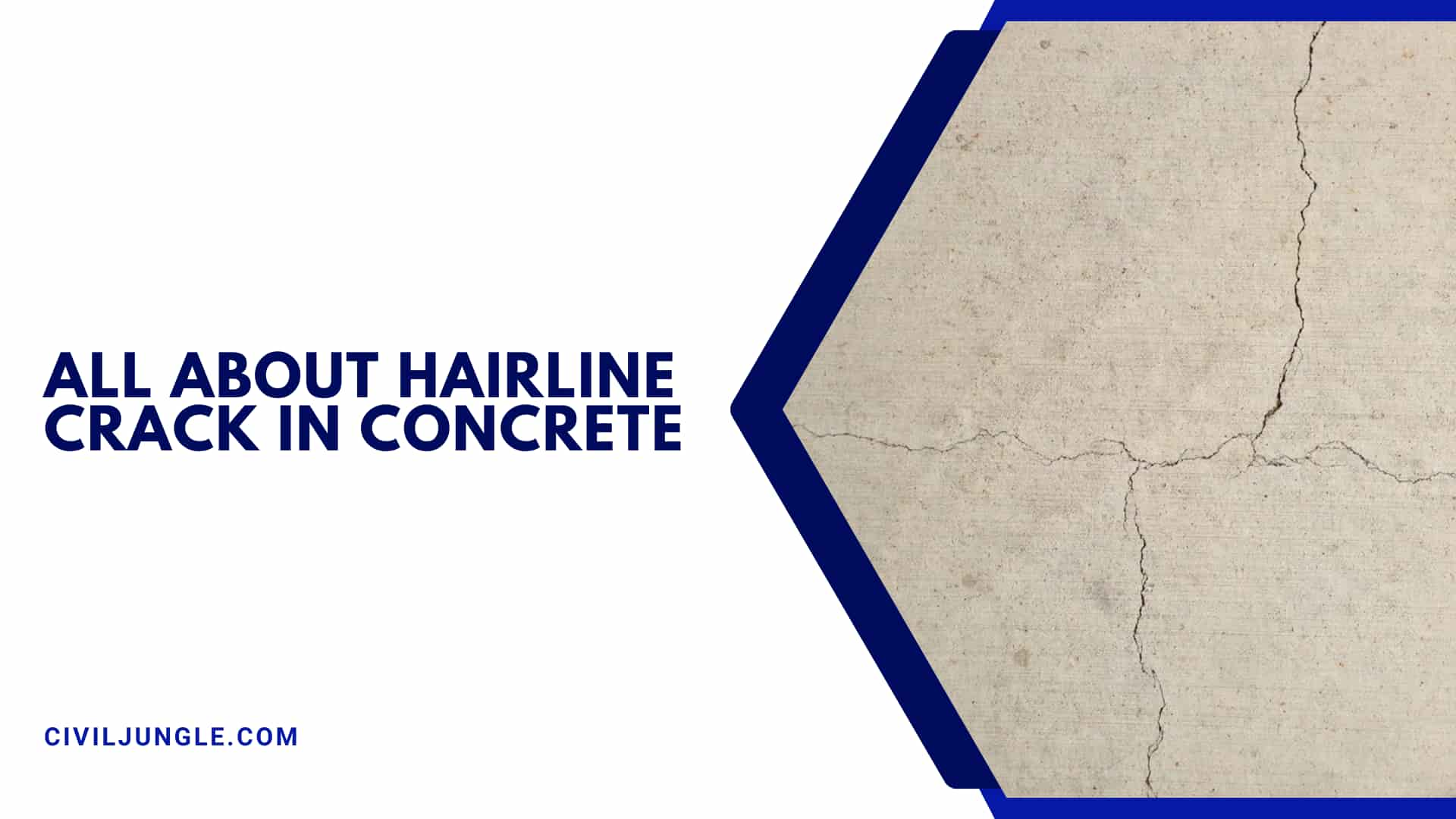
What’s A Hairline Crack In Concrete?
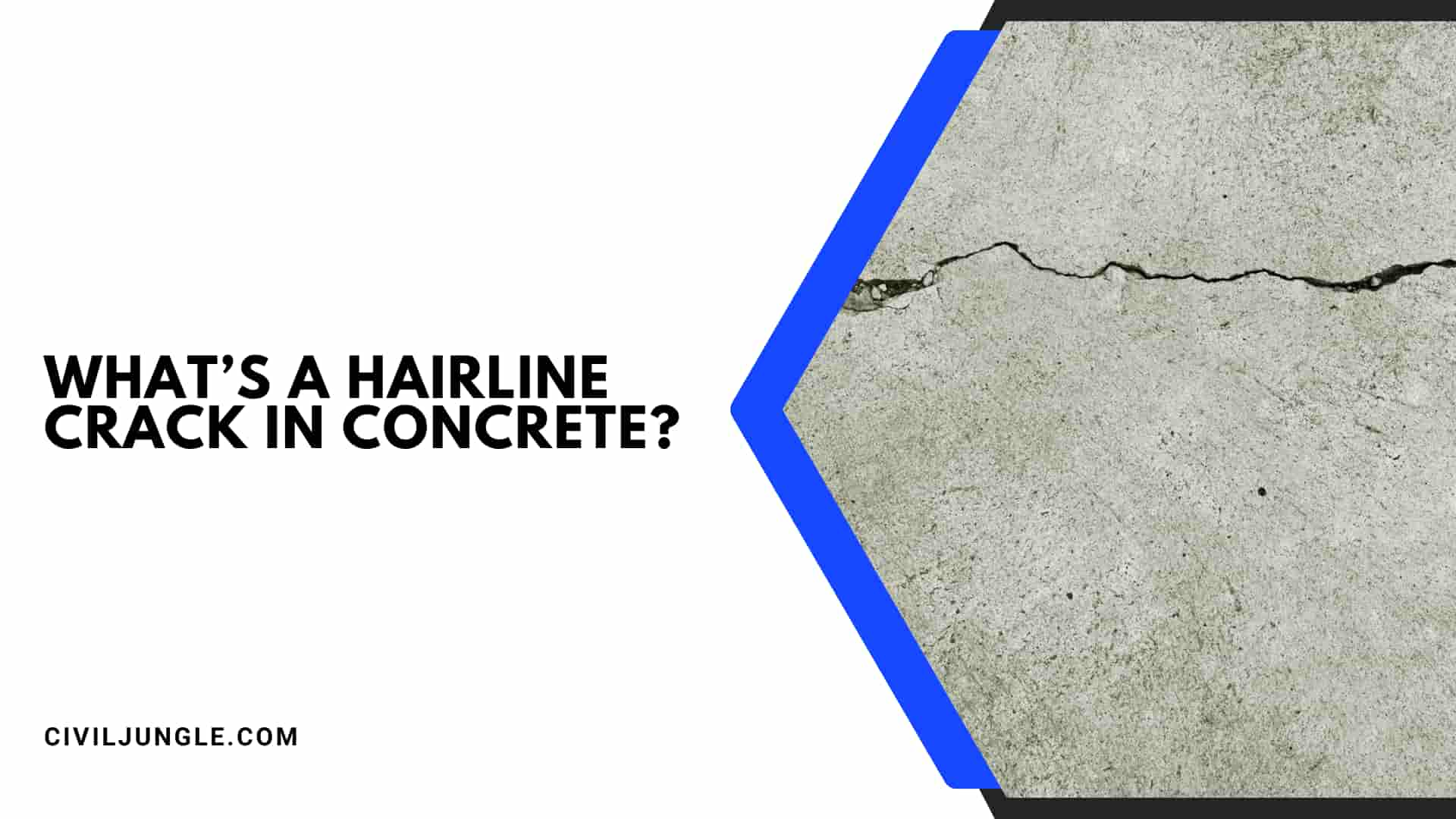
A hairline crack is a fragile but deep crack in the concrete. Due to the depth, as the concrete solidifies during curing, these cracks may allow for more severe damage after the concrete has hardened. The width of human hair and hairline cracks in the concrete are very narrow.
Due to plastic shrinkage is the occurrence, hairline cracks are commonly observed in freshly placed concrete. As the name suggests, their fissures are tiny, about 0.003 inches (0.08 mm) wide—and very shallow.
Concrete is hairline cracks in extremely common but often misunderstood. Hairline cracks are challenging to repair. And the possible damage to the hairline is not a sign of poor quality.
The common hairline cracks are in the new construction of foundations in the country. Drying out of the new foundation usually appears within a year and is caused by freezing. And these cracks are typically cosmetic and can be repaired for ~$200 or by professionals for $400-$600.
The best to avoid hairline cracks is to let the concrete cure off slowly. Covering the surface in plastic keeps the concrete moist from pouring water over it. A slow curing process with bits helps prevent cracks and makes for that stronger concrete.
What Causes Hairline Cracks In Concrete?

Shrinkage in concrete is the major cause of hairline cracks. Concrete is wetted and then dried, and as the concrete dries, it becomes hard and strong. This process is called curing. And it takes a total of 28 days to complete. But it is the first day that is most important when preventing hairline cracks.
The main reason behind hairline cracks in concrete is stress relief from drying or heat caused by shrinkage. On it, concrete quickly loses moisture, and small cracks may form. To prevent this, the drying process can be slowed by keeping the surface of the concrete moist.
It can be of two types.
- Cover the concrete with plastic wrap on the first day because it can dry out. They will keep the surface moist and slow down drying.
- Sprinkling water lightly on the surface of the concrete can keep its surface moist.
The appearance of air cracks on the surface of the concrete is due to variations in temperature, relative humidity, and air velocity. Hairline concrete cracks for other reasons. These factors can cause excessive high evaporation in hot and cold weather to dry out too quickly.
The chances of hairline cracks are factors that increase the following:
- The subgrade is formed due to water loss, formwork, or aggregate absorption.
- The causes of bleeding and sedimentation of concrete segregation
- Poor workmanship and negligence
- Alkali-gross reactions
- Portland cement type and ingredients (additives such as fly ash, silica fume, etc.)
- Due to the type and dosage rate of the chemical mixture.
- The construction of works such as screeds and finishing works.
- Hairline cracking can also be caused by exposure to heat.
- Pouring Concrete
- Inadequate Curing Period
Also Read: Concrete Mix Ratio | What Is Concrete Mix Ratio | Types of Concrete Mix Ratio
How To Prevent Hairline Cracks In Concrete?
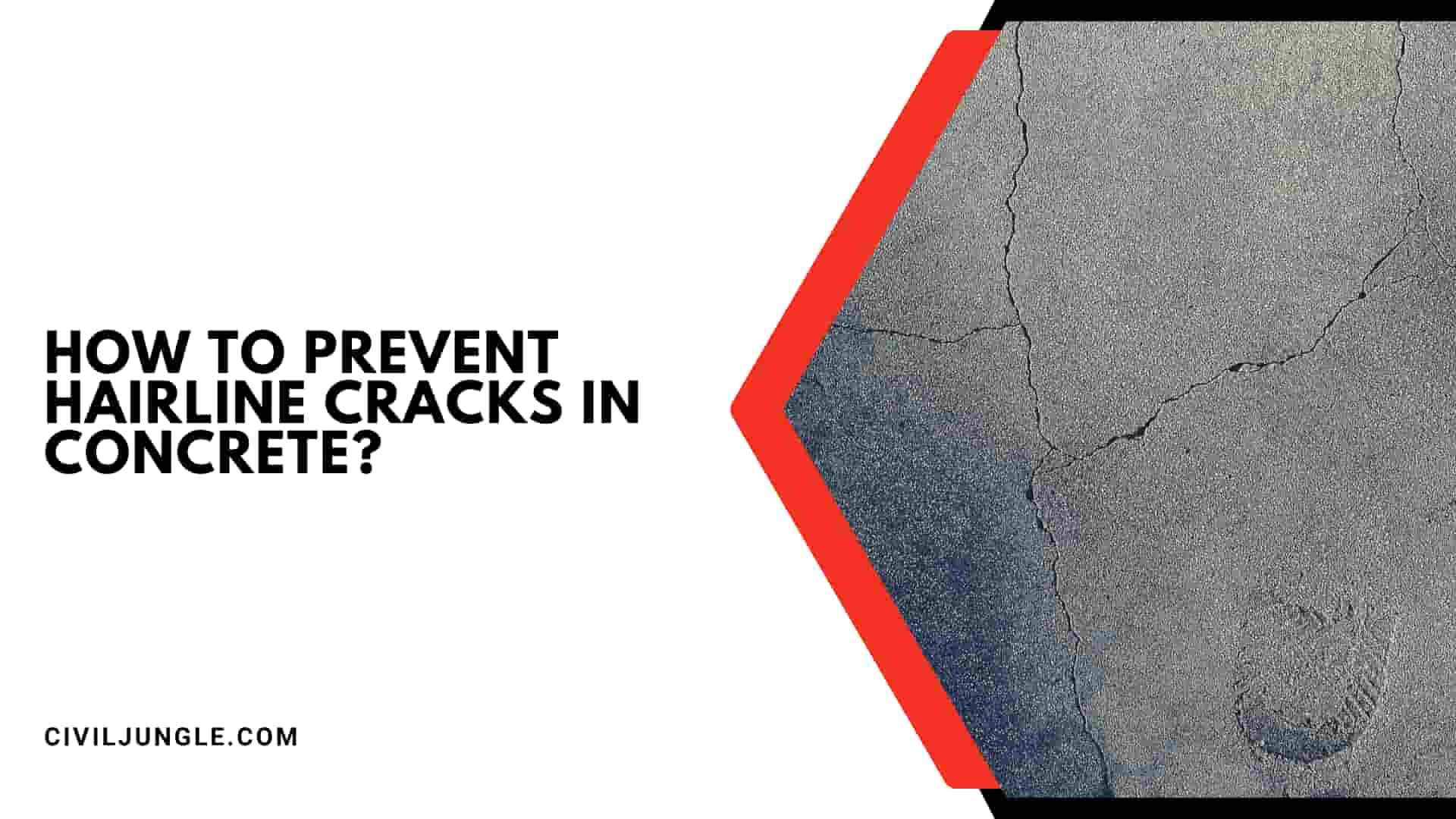
There are many methods and techniques to prevent cracks in case of rapid moisture loss due to hot weather and dry winds. The rapid moisture loss due to hot weather, additives, chemicals, dry air, aggregate, and poor workmanship can be dealt with in various ways.
A reliable contractor can install your concrete wall, patio, driveway, or deck. And some other tips to keep your concrete from cracking later.
Here are a few preventions to prevent these cracks:
- The air above the surface can be saturated using a fog nozzle.
- The surfaces have a plastic sheet to cover them. Maintains the final finish operation that evaporates the moisture on the concrete.
- The use of windbreaker barriers and sunshades that reduce wind velocity also helps reduce surface temperatures.
- Moisten the subgrade and formwork by removing excess water before placing the concrete. Their absorption prevents moisture from the concrete.
- If the temperature is not favorable, an evaporation retarder can be used.
- Microfibers have to be used in the concrete mix to increase the tensile strength of plastic concrete.
- Troweling and other finish operations draw moisture into the surface, so overworking should avoid the concrete surface.
- As soon as the finishing is completed, should start the curing process without any delay.
- Be careful when adding paint to concrete. They suck water out of concrete.
- Do not add too much water to the concrete mix; This weakens the concrete, making it more prone to cracking.
How To Repair Hairline Cracks In Concrete?
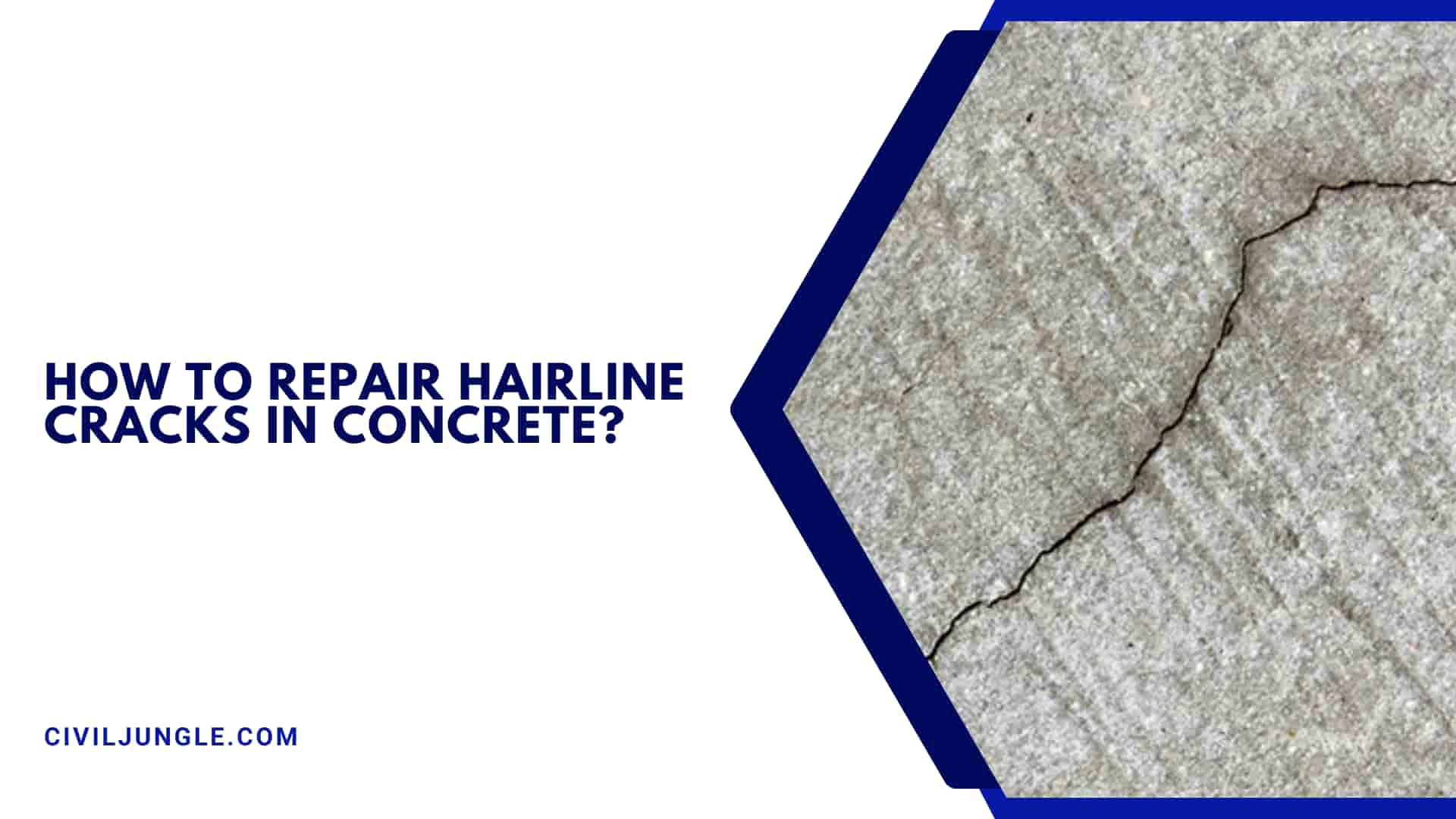
A hairline crack involves repairing and filling a gap in the concrete’s structure, using a material that adheres well to the concrete, restoring its original appearance, and preventing liquids from preventing it happening. Fissures cannot be completely treated, but their appearance can be minimized.
The steps involved in repairing hairline cracks in the concrete are as follows:
Cleaning the Cracked Surface and Interior:
The first and foremost step in repairing hairline cracks in concrete is inspection and cleaning. The foreign matter covering cleans off the surface before applying the filling material to obtain a proper bond. Once the crack is properly removed, You must clean any dirt or stains from the areas.
Preparation of Sealant to Fill the Hairline Crack:
The most common grout is a mixture of Portland cement and water. A hairline crack repair means sealing it with sealant. Sealants are filler materials that are used to penetrate cracks and seal them. You must add enough water to make a good quality grout mix for hairline cracks.
- Silicone or latex caulking: Both products are great for filling and sealing the cracks below as they appear after sealing the crack.
- Paint: Paints are much thicker than sealers. They fill all the cracks and cover the entire surface completely. Unlike sealers, paints do not require repeated applications.
- Concrete sealers and epoxy: These sealers are used not only for cracks but for the entire surface of the concrete. Makes them less noticeable than a spot of the repairs. But sealers wear off and need to the reapplied as needed.
- Polymer-modified cement grout: There is also another great product for sealing hairline concrete cracks after repair.
Applying Sealant to the Cracks:
Our professionals at Big D Ready Mix Concrete recommend using a pointing trowel or putty knife to apply the grout properly for the best results.
The excess material that has come loose is smoothed and leveled to match the existing surface. Grout is applied in the same way as caulk sealant.
The ground needs to be inside the crack as much as possible. Concrete sealers and epoxy are applied with the squeegee, paint roller, and brush. Concrete paints are roller for large areas and a brush for the smaller spots.
Making the Cracks Moist:
The hairline cracks on an old concrete surface should be moistened with that water for about 7 hours before grout or filling material is applied to the crack.
The concrete will help prevent the area from absorbing the water from the applied grout. Water from the surface is not required to wet or seal the crack or to close the crack. If this happens, your grout will dry before properly sealing the crack.
Concrete Crack Treatment:
The sealant was installed correctly and allowed curing for the sealant to work completely. And the dry time should adjust the season and temperature. The hotter the temperature, the faster the sealant will dry. And the colder the temperature, the longer it will take to dry.
The Final Stage’s Moisture Content Also Affects the Concrete’s Curing:
Sealed cracks should dry for at least two hours and be covered with boards or plastic sheets. And it is necessary To cover the area for about five days. Every day should lift the lid should sprinkle water on the surface. Like concrete, the sealant needs to dry quickly. They cause shrinkage and cracks. Hair fall is a small problem. It’s only controlled and is challenging to eliminate.
Hairline Crack Repair Is Mainly Cosmetic
The sealant and grout sealant is easier to squeeze into the wider cracks. There is little space to fill with anything other than a low-viscosity liquid. Your only option may be to seal the concrete surface instead of just spot-fixing it. The hairline cracks do not affect the structural integrity of the slab. Sealing the crack is the main focus of the repair.
The hairline crack repair in concrete is challenging because it is so small. It is cosmetic and more of a fix than larger cracks. But it should be done even then because small hairline cracks can open up over time, and if ignored, they need to be sealed immediately to prevent future damage; otherwise, it will allow more water to seep.
Also Read: Washer Types and Uses
Acceptable Concrete Cracks
Concrete is a very common hairline crack but is misunderstood. Most people see cracks in concrete when it is new, and they assume there is a problem. Hairline cracks used to be of no concern and are mostly cosmetic. That doesn’t mean we should ignore it.
The cracks identified as small and fine are considered acceptable as part of minor settlement depending on the purpose and intent of the concrete structure, the environment in which it is placed, and that Design form of life and durability.
How To Hide Hairline Cracks In Concrete?
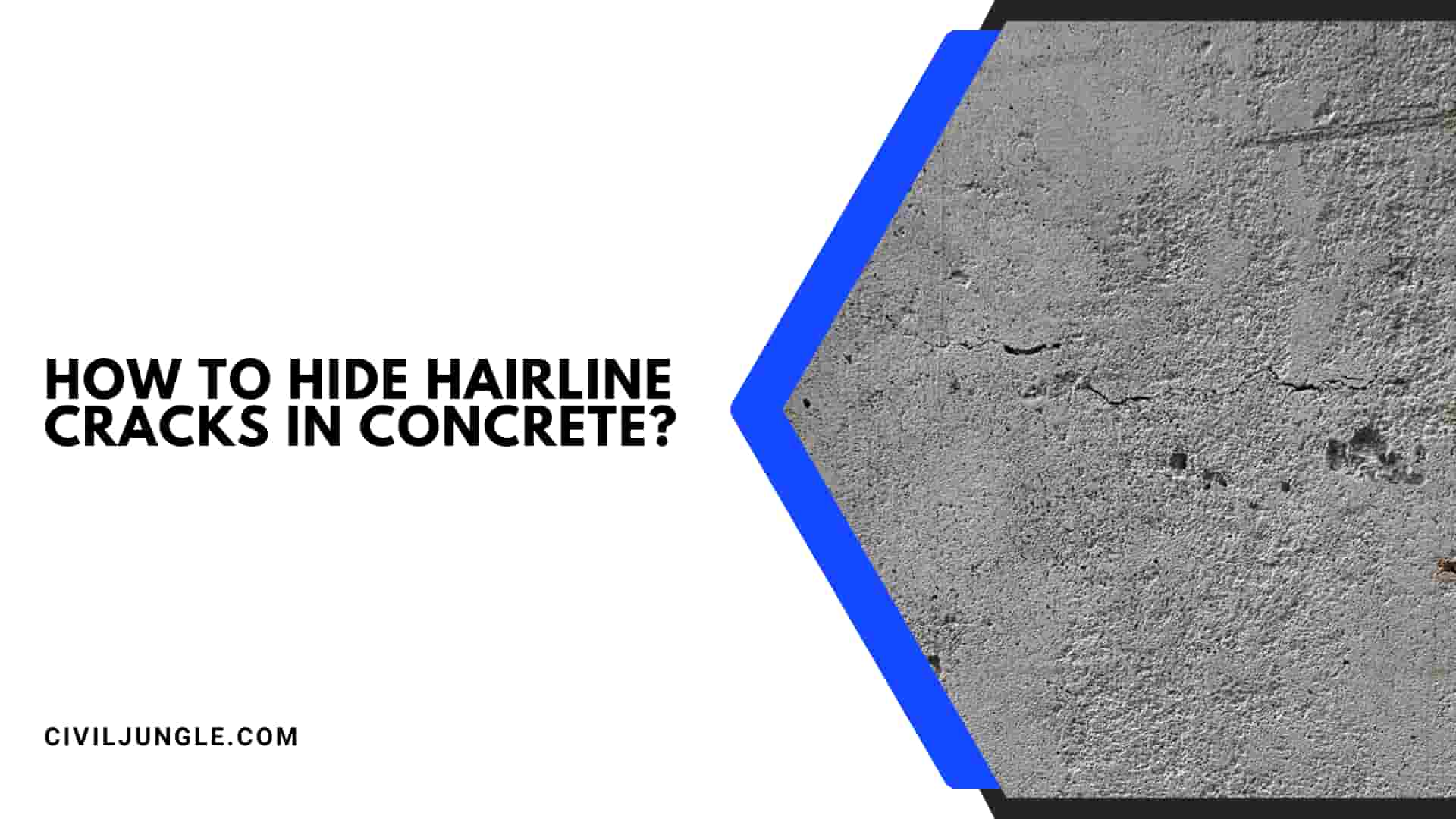
The most commonly used for grout concrete is portland cement, to which you must add enough water to make that a good quality grout mix. Covering hairline cracks in concrete is the best way to hide them with paint. Painting the concrete off-site eliminates cracks, while other sealers may still be visible. In addition to cement grout, other filler materials or sealants can also fill the cracks.
- Paint is the only way to completely cover and hide hairline concrete cracks.
- Caulk and grout may be visible after the crack is repaired.
- Even if the texture is different, you will match the color perfectly.
- Sealers are great at protecting concrete slabs and repairing cracks but are also transparent; you can still see the cracks in them.
Also Read: M30 Grade of Concrete Mix Design Procedure with OPC 53 Cement
Should You Fix Hairline Cracks In Concrete?
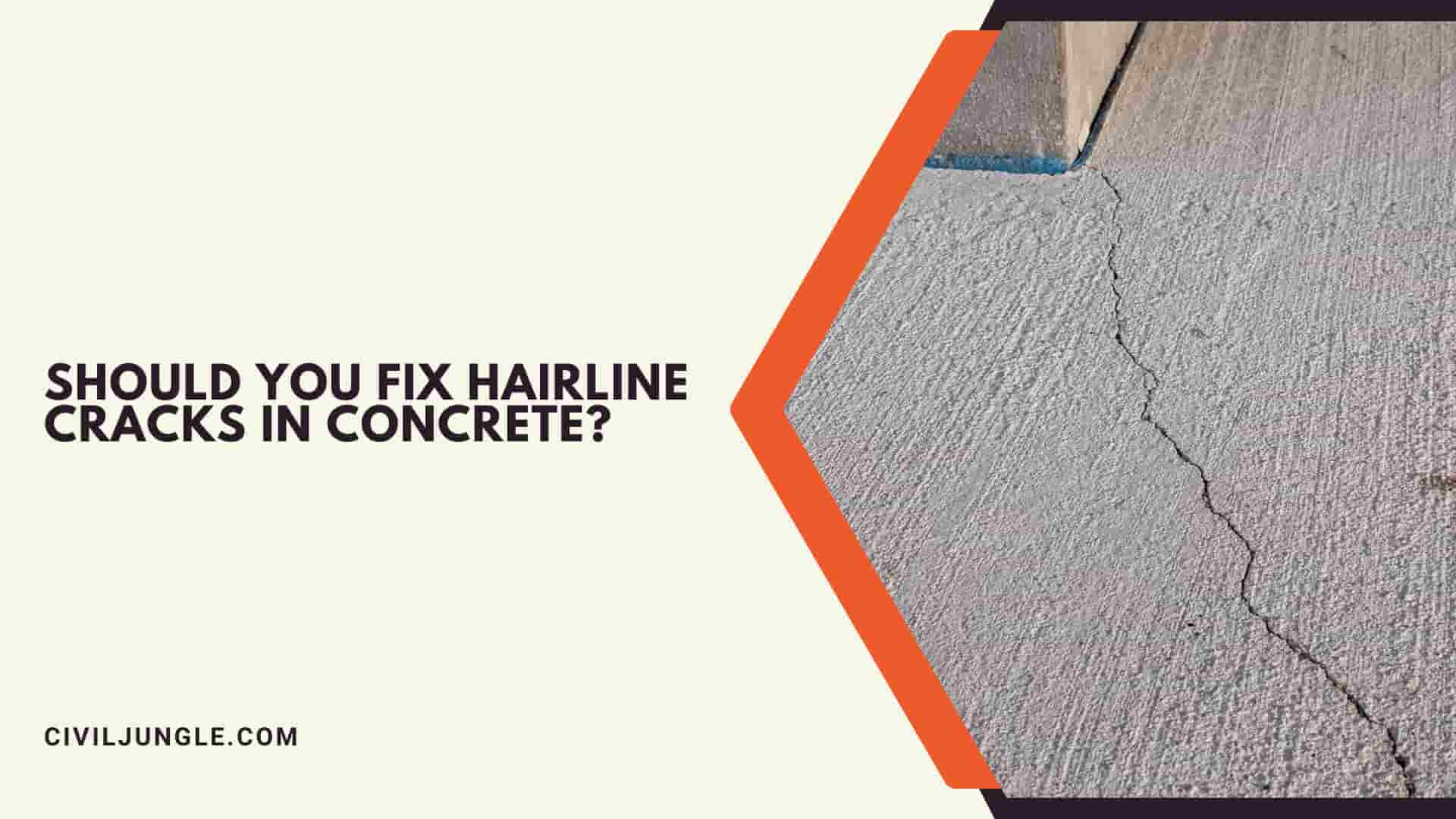
Yes, We should fix hairline cracks in the concrete to prevent them from worsening. The hairline cracks that appear only Indoors or on the patio and sidewalk surfaces are usually safe and filled to prevent water from entering the aqueduct, causing further deterioration.
The first thing is determining the severity of the crack. Hairline cracks that appear only indoors or on patio and sidewalk surfaces are usually safe and filled to prevent water from entering the aqueduct, and if a hairline crack is not sealed, then moisture can get inside.
Over time it can also cause the edges to peel and break. Cracks are also great for accumulating organic matter, especially in shaded, moist areas, which can lead to mold and mildew growth. If you see hairline or any other concrete cracks, they should seal the entire slab. And then, spot-repair the crack and preserve the rest of the slab.
Hairline Crack in Concrete
Hairline Crack in Foundation
Hairline cracks are common in new construction foundations across the country. They usually appear within one year and caused by the settling and drying of the new foundation. The good news is these cracks are usually cosmetic and can be repaired by DIY homeowners for ~$200 or professionals for $400-$600.
Hairline Cracks in Concrete Driveway
The causes for these cracks to show up can be due to the variations in air temperature, concrete temperature, relative humidity and wind velocity at the surface of the concrete. These factors can cause high rates of evaporation in either hot or cold weather.
Settlement Cracks in Concrete Slab
Settlement. Settlement cracks may appear when the underlying ground has not been compacted or appropriately prepared or if the subsoil was not of the proper consistency. A settlement crack may also appear as a random crack above areas where the soil of the subgrade was uneven after the concrete was poured.
Types of Cracks in Concrete Slabs
- Plastic shrinkage concrete cracks.
- Expansion concrete cracks.
- Heaving concrete cracks.
- Settling concrete cracks.
- Concrete cracks caused by overloading the slab.
- Concrete cracks caused by premature drying.
Acceptable Cracks in Concrete Slab
Generally, cracks with a width of less than 0.3 mm are acceptable and do not affect the structure. However, they may develop and grow to become structural cracks. Therefore, one should monitor small cracks on houses or structures. Crack width greater than 0.3 mm can create problems for the durability of the structure.
Hairline Crack Definition
A hairline fracture, also known as a stress fracture, is a small crack or severe bruise within a bone. This injury is most common in athletes, especially athletes of sports that involve running and jumping. People with osteoporosis can also develop hairline fractures.
How to Prevent Hairline Cracks in Concrete?
- Use of fog nozzles to saturate the air above the surface.
- Use of plastic sheeting to cover the surface between the final finishing operations.
- Use of to reduce the , sunshades to reduce the surface temperature are also helpful.
How to Hide Hairline Cracks in Concrete?
- Cleaning and preparation: Begin by thoroughly cleaning the cracked area of any dirt, debris, or loose concrete. Use a stiff brush or a pressure washer to remove any loose particles. Allow the area to dry completely before proceeding.
- Filling the cracks: Use a concrete patching compound or epoxy resin specifically designed for repairing cracks. These products are available at most hardware or home improvement stores. Follow the manufacturer’s instructions for mixing and applying the compound. Use a putty knife or a trowel to fill the cracks, ensuring the material is pressed firmly into the crack and leveled with the surrounding surface. Smooth out the patched area to create a seamless finish.
- Colored filler: If you want to further conceal the crack, consider using a colored filler that matches the surrounding concrete. Some concrete patching compounds come in a variety of colors, or you can add a concrete dye or pigment to the mixture to achieve the desired color. Apply the colored filler over the patched area, following the manufacturer’s instructions.
- Texturing: To blend the repaired area with the rest of the concrete, you can try adding texture. Use a texture roller or a broom to create a pattern that matches the existing concrete surface. This will help camouflage the repaired area and make it less noticeable.
- Staining or painting: Another option to hide hairline cracks is to stain or paint the entire concrete surface. Concrete stains or paints can provide a uniform color and finish, making the cracks less noticeable. Make sure to clean the surface thoroughly before applying the stain or paint, and follow the manufacturer’s instructions for proper application and drying times.
- Decorative options: If you’re open to more creative solutions, you can explore decorative options such as applying a concrete overlay, using decorative tiles or pavers, or adding a concrete overlay with a stamped pattern. These methods can help disguise the cracks while adding visual interest to the surface.
Are Hairline Cracks in Concrete Normal?
Hairline cracks in a concrete slab are rarely a cause for concern. They can be controlled, but not eliminated. A crack in a slab of 1/8 inch or less is typically a normal shrinkage crack and not a cause for concern.
How to Hide Hairline Cracks in Concrete?
- Clean the surface: Begin by cleaning the cracked area to remove any dirt, debris, or loose particles. Use a wire brush or a pressure washer to thoroughly clean the crack. Allow the surface to dry completely.
- Fill the cracks: Use a concrete crack filler or a concrete patching compound designed for hairline cracks. These products are available at most hardware or home improvement stores. Follow the manufacturer’s instructions for mixing and applying the filler. Typically, you’ll apply it with a caulking gun or a trowel, making sure to fill the crack completely. Smooth out the filled area to create a level surface.
- Sand the surface: Once the filler has dried, lightly sand the surface to ensure it is smooth and flush with the surrounding concrete. Use fine-grit sandpaper or a sanding block to gently sand the patched area.
- Apply a concrete sealer: To further hide the cracks and protect the surface, apply a concrete sealer. Choose a clear or colored concrete sealer that matches the rest of the concrete. Apply the sealer using a brush or a roller, following the manufacturer’s instructions. Make sure to cover the patched area as well as the surrounding concrete for a consistent appearance.
- Camouflage with texture: If the crack is still somewhat visible after filling and sealing, you can try adding texture to the surface to help camouflage it. Use a broom, a texture roller, or a concrete stamp to create a pattern or texture that matches the existing concrete. This will help blend the repaired area with the rest of the surface.
- Consider decorative options: If you prefer a more decorative approach, you can explore options such as staining, painting, or adding overlays to the concrete surface. Stains or paints can provide a uniform color and finish, making the cracks less noticeable. Concrete overlays can be applied to the entire surface or just the cracked area to create a fresh and updated look.
Should You Fix Hairline Cracks in Concrete?
Hairline cracks or cracks under 1/4-inch wide may not indicate serious underlying damage, but if water gets into them and repeatedly freezes and expands, and vehicles continue to drive over them, the cracks can get bigger and the problem can worsen. These cracks can usually be repaired.
How to Fix Hairline Cracks in Concrete Driveway?
Pour enough dry concrete mix into a 5-gallon bucket to repair any cracks and patch damaged areas. Sand mix or concrete resurfacer, which do not contain gravel, may be used if the area to be repaired is not large or deep. A standard concrete mix that contains gravel works best for patching large or deep areas.
Hairline Crack Detection and Inspection in Concrete
Hairline cracks in concrete can be challenging to detect and inspect due to their small size. However, there are several methods you can use to identify and assess hairline cracks:
- Visual inspection: Conduct a thorough visual inspection of the concrete surface. Look closely for fine, narrow cracks that may appear as thin lines. Use good lighting and a magnifying glass if necessary to aid in detection.
- Dye or chalk testing: Apply a colored dye or chalk to the concrete surface. The dye or chalk will seep into the cracks, making them more visible. After applying the dye or chalk, wipe off the excess and observe the surface for any visible cracks highlighted by the color.
- Acoustic emission testing: Acoustic emission testing involves listening for sounds emitted by cracks under stress. Specialized equipment, such as acoustic emission sensors or microphones, is used to detect the high-frequency sounds produced by cracking. This method is particularly useful for detecting hairline cracks in reinforced concrete structures.
- Ultrasonic testing: Ultrasonic testing uses high-frequency sound waves to detect internal cracks or defects in concrete. A transducer is placed on the concrete surface, and ultrasonic waves are transmitted into the material. Any cracks or flaws in the concrete will reflect the waves, allowing for their detection.
- Ground penetrating radar (GPR): GPR is a non-destructive testing method that uses radar pulses to create an image of subsurface structures. It can be effective in identifying hairline cracks within the concrete. GPR equipment emits electromagnetic waves into the concrete, and the reflected waves are analyzed to create an image that shows the location and extent of cracks.
- Infrared thermography: Infrared thermography involves using a thermal camera to detect temperature variations on the concrete surface. Hairline cracks often have different thermal properties than the surrounding concrete, causing temperature differences. By using infrared imaging, you can identify these temperature variations and potential crack locations.
Preventing Hairline Cracks in Concrete
Prevention of Hairline Cracks in Concrete
- Use of fog nozzles to saturate the air above the surface.
- Use of plastic sheeting to cover the surface between the final finishing operations.
- Use of to reduce the , sunshades to reduce the surface temperature are also helpful.
- Dampen the subgrade and formwork, ensuringthat any excess water is removed prior to placing concrete
- Applying a sprayable evaporation retardant
- Use of microfibers in the concrete mixture toincrease the tensile capacity of the plastic concrete.
- Starting of curing processas soon as possible after finishing.
Hairline Crack Repair Products for Concrete
There are various hairline crack repair products available for concrete that can help to seal and repair small cracks. Here are a few commonly used options:
- Concrete Crack Sealant: This is a liquid or paste-like material specifically designed for filling and sealing hairline cracks in concrete. It is typically applied using a caulk gun or trowel. Concrete crack sealants are often elastomeric, meaning they have some flexibility to accommodate minor movements in the concrete.
- Concrete Repair Epoxy: Epoxy-based products are commonly used for repairing hairline cracks in concrete. These two-component systems consist of a resin and a hardener that are mixed together prior to application. Epoxy fills and bonds to the crack, providing a durable and strong repair.
- Injection Systems: Injection systems involve injecting a specialized repair material into the hairline crack using pressure. These systems are often used for cracks that are actively leaking or are subject to movement. The injection material can be epoxy, polyurethane, or other specialized compounds.
- Concrete Patching Compound: Patching compounds are available in powder or pre-mixed form and can be used to repair hairline cracks in concrete. They are usually a blend of cement, aggregates, and additives. The compound is mixed with water to a workable consistency and then applied to the crack using a trowel or putty knife.
- Concrete Crack Repair Kits: There are also crack repair kits available that provide a complete set of materials and instructions for repairing hairline cracks. These kits often include a combination of crack sealant, epoxy, or injection materials, along with tools and accessories needed for the repair process.
Causes of Hairline Cracks in Concrete
Causes of Hairline Cracks in Concrete
- Water loss due to absorption by subgrade, formwork or aggregate.
- Bleeding and sedimentation.
- Poor workmanship and negligence.
- Alkali-Aggregate reactions.
- Type and content of Portland cement and supplementary cementitious materials (fly ash, silica fume,etc.)
- Type and dosage rate of chemical admixtures.
- Construction operations like screeding and finishing operations.
How to Repair Hairline Cracks in Concrete
- Chisel out the crack to create a backward-angled cut. This provides a wider surface area for the repair, which will help it better adhere to the main body of concrete. The goal is to create a backwards “V” so the repair can’t back out.
- Clean out any loose material from the crack. Any loose gravel or debris in the crack will keep the filler material from properly bonding, and the repair won’t hold.
- Apply a thin layer of bonding adhesive. This step is frequently neglected but is critical for ensuring that the sealer/filler adheres to the existing concrete structure. This material is designed to permanently connect new concrete or plaster to old concrete or plaster. It improves adhesion and increases resilience and flexibility of the repair.
- Mix and trowel reinforced patching compound into the crack. Depending on the size of the patch, you may use a caulk tube, bottle or pre-mixed compound from a bucket to make the repair.
Like this post? Share it with your friends!
Suggested Read –
- Difference Between Lime and Cement | What Is Lime (Hydraulic) | What Is Cement
- Difference Between Mat Foundation and Spread Footing | What Is Mat Footing | What Is Spread Footing
- Portland Cement Uses | How to Use Portland Cement | What Is Portland Cement Used for | How Is Portland Cement Made | Why Is It Called Portland Cement
- What Is Frost Wall | Types of Frost Wall | Requirements for Frost Wall Construction | Application of Frost Wall | Advantages of Frost Wall | Uses of Frost Wall
- How to Build a Suspension Bridge | Suspension Bridge Facts | Suspension Bridge-Strength & Weaknesses | Advantages and Disadvantages of a Suspension Bridge

